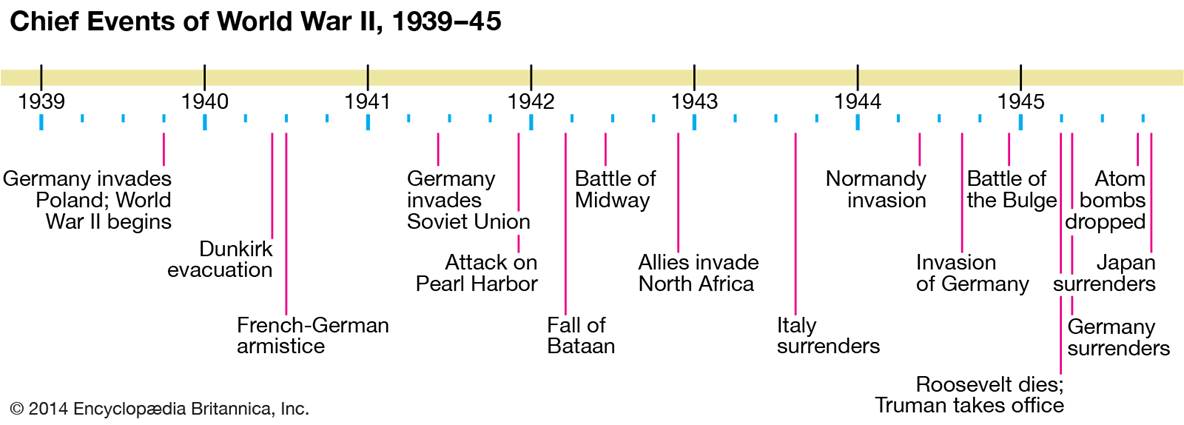From Isolation to World War II
(1930-1945)
Mobilization
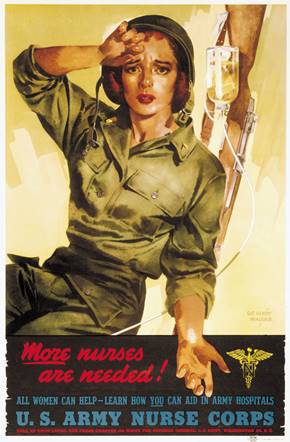
Figure 1 World War II: poster. Image. Britannica
LaunchPacks, Encyclopedia Britannica, 8 Feb. 2020
Army Nurse Corps poster
from World War II reading, “More nurses
are needed! All women can help—learn how you can aid in army hospitals.
Content Statement #21
United
States policy and mobilization of its economic and military resources during
World War II affected American society. Despite mistreatment, marginalized
groups played essential roles in the war effort while continuing to protest
unfair treatment.
Content
Elaborations
1.
The policy and mobilization
of the United States at the outbreak of World War II greatly impacted the lives
of Americans. Aspects of wartime policy and mobilization included:
a.
the transition from peacetime to wartime
economy (e.g., price controls, War Production Board);
b.
personal sacrifices for the war effort (e.g.,
rationing, victory gardens);
c.
military mobilization efforts (e.g., the military
draft, naval expansion);
d.
contributions to the war effort (e.g., war
bonds, scrap drives); and
e.
propaganda efforts by the government.
2.
Job opportunities in the
civilian workforce and the military opened for women and minorities.
3.
Marginalized groups and their
experiences during World War II included:
a.
African Americans (e.g., Double V Campaign);
b.
Japanese Americans (e.g., internment camps);
c.
American Indians (e.g., Navajo Code Talkers);
and
d.
Mexican Immigrants (e.g., Bracero Program).
Let’s Practice: Key Terms
Section A: Mobilization
In the wake
of the attack on Pearl Harbor, Hawaii, and the subsequent declaration of war,
Americans were asked to take on numerous and varied roles to support the war
effort at home. The policy and mobilization of the United States at the
outbreak of World War II greatly impacted the lives of Americans. Aspects of wartime
policy and mobilization included:
Ø War Production Board
o efforts to outproduce its opponents.
o the board was responsible for establishing the needs for the war
o allocating the resources and organizing the production and
distribution of supplies
Ø Rationing
o concept of reducing, reuse and recycle
o Gasoline, meat, and sugar were just some of the goods rationed
o “Victory Gardens” à grown by families and
communities to not disrupt the flow of vegetables to soldiers abroad
Ø Military Efforts
o A peacetime draft
was instituted in 1940 to supplement military enlistments
o Naval expansion into Europe and Asia
Ø Contributions
o Citizens purchased war bonds to help fund the war
o Some labor unions signed no-strike pledges
o Scrap
drives were conducted to reallocate materials for war goods
Ø Propaganda
o The government created posters to tout positive patriotic
messages
o Below are examples of WWII propaganda posters
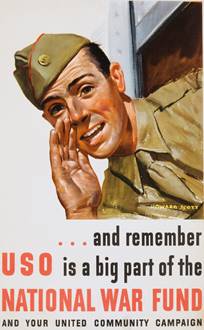
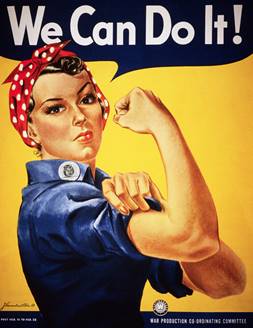
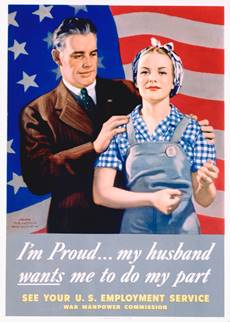

Section B: Civilian Workforce
Job
opportunities in the civilian workforce and the military opened for women and minorities.
Ø 300,000 Mexican Americans served in World War II
Ø 25,000 Native American served in World War II
o 400 Navajo radio operators = “code talkers.”
Ø 500,000 African Americans
o Tuskegee Airman
Ø 350,000 American Women volunteered for military service
Let’s Practice: Matching
Game
Section C: Marginalized Groups
World War II
created new opportunities for women, African Americans, and other minority
groups. World War II provided
unprecedented job and service opportunities to women and minorities on the U.S.
home front, thus laying the groundwork for the civil rights and feminist
movements later to come.
Ø African Americans
o Double V Campaign
§ African American initiative, led by the Pittsburgh Courier
newspaper that aimed to achieve a double victory
(“Double V”) during World War
II.
§ The two objectives were victory in the war abroad and victory
against discrimination on the home front
o Tuskegee Airmen
§ First African American pilots in the U.S. military
§ Proved equality of African American pilots
Ø Japanese Americans
o Internment
§ U.S. government forced some 120,000 Japanese Americans to leave
their homes
§ moved to internment centers, or concentration camps
§ Japanese Americans who were detained in the camps lost their
freedom, their civil liberties, their jobs, and in most cases their property
Ø Native Americans
o Navajo Code Talkers
§ U.S. Marines who created and used a code to keep military
secrets during World War II
§ played a key role in the United States’ victory over Japan
§ 400 Navajo men were trained as code talkers
Ø Mexican Immigrants
o Bracero Program
§ short-term contract laborers from Mexico, known as braceros,
to work legally in the United States
§ use to combat a wartime shortage of agricultural laborers due to
military service
Let’s Practice: Slideshow
Section D: Overview of World War II
World War II
killed more people, involved more nations, and cost more money than any other
war in history. Altogether, 70 million people served in the armed forces during
the war, and 17 million combatants died. Civilian deaths were ever more
significant. At least 19 million Soviet civilians, 10 million Chinese, and 6
million European Jews lost their lives during the war.
World War II was right, a global war. Some 70 nations took part in the
conflict, and fighting took place on the continents of Africa, Asia, and
Europe, as well as on the high seas. Entire societies participated as soldiers
or as war workers, while others were persecuted as victims of occupation and
mass murder.
World War II cost the United States a million causalities and nearly 400,000
deaths. In both domestic and foreign affairs, its consequences were
far-reaching. It ended the Depression, brought millions of married women into
the workforce, initiated sweeping changes in the lives of the nation's minority
groups, and dramatically expanded the government's presence in American life.
On September
1, 1939, World War II started when Germany invaded Poland. By November 1942,
the Axis powers controlled territory from Norway to North Africa and from
France to the Soviet Union. After defeating the Axis in North Africa in May
1941, the United States and its Allies invaded Sicily in July 1943 and forced
Italy to surrender in September. On D-Day, June 6, 1944, the Allies landed in
Northern France. In December, a German counteroffensive (the Battle of the
Bulge) failed. Germany surrendered in May 1945.
The United States entered the war following a surprise attack by Japan on the
U.S. Pacific fleet in Hawaii. The United States and its Allies halted Japanese
expansion at the Battle of Midway in June 1942 and other campaigns in the South
Pacific. From 1943 to August 1945, the Allies hopped from island to island
across the Central Pacific and also battled the Japanese in China, Burma, and
India. Japan agreed to surrender on August 14, 1945, after the United States
dropped the first atomic bombs on the Japanese cities of Hiroshima and
Nagasaki.
